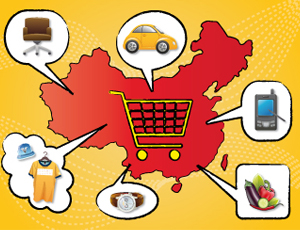Certifications for Imported Goods in China
By Shirley Zhang and Eunice Ku
 Oct. 17 – China has various inspection and certification requirements for imported goods. Chinese product certification standards are to a large extent aligned with the European International Standards Organization and American Standard Test Methods. However, China has independent applications for testing procedures that must be conducted in a licensed Chinese laboratory. The certification processes are not more expensive than elsewhere, but are very time consuming. The time frame varies by the certification processes and depending on the product, there may be only one necessary test, or a series of tests performed in multiple labs. Below, we discuss some of the major certifications in China.
Oct. 17 – China has various inspection and certification requirements for imported goods. Chinese product certification standards are to a large extent aligned with the European International Standards Organization and American Standard Test Methods. However, China has independent applications for testing procedures that must be conducted in a licensed Chinese laboratory. The certification processes are not more expensive than elsewhere, but are very time consuming. The time frame varies by the certification processes and depending on the product, there may be only one necessary test, or a series of tests performed in multiple labs. Below, we discuss some of the major certifications in China.
China Compulsory Certification
The China Compulsory Certification (CCC) mark is a compulsory safety mark for domestically-manufactured and imported products listed in the CCC Product Catalogue, approved and jointly released by the General Administration for Quality Supervision and Inspection and Quarantine (GAQSIQ) and the Certification and Accreditation Administration (CNCA). CCC was implemented on May 1, 2002 and became fully effective on August 1, 2003. The CCC mark is administered by CNCA, which designates the China Quality Certification Centre (CQC) to process CCC mark applications. The CCC Product Catalogue includes electric appliances, vehicles, safety glasses, medical equipment and toys, etc.
GAQSIQ is an administrative department directly under the State Council. It is in charge of quality supervision, inspection, animal and plant quarantine, and food safety for all goods transported across the Chinese border. It also supervises the CNCA and the Standardization Administration of China (SAC), as well as Entry-Exit Inspection and Quarantine Bureaus throughout China.
CNCA is responsible for legislating inspection and quarantine standards and relevant regulations. CQC is a professional certification body under the China Certification & Inspection (Group) Co., Ltd. (CCIC). CCIC was originally established with accreditation by GAQSIQ, CNCA, and the National Accreditation Service for Conformity Assessment of China, but is now an independent enterprise. It is China’s largest international enterprise providing inspection, authentication, certification, and product testing services worldwide with regard to the quality, safety, health, and environmental protection aspects of products. It has approximately 300 offices and 200 testing laboratories located at major ports, cities and trade centers in more than 20 countries and regions.
Certificates issued by CCIC based on their inspection and testing are accepted and sometimes required by government authorities. For example, when selling waste products to China, CCIC’s inspection prior to loading them onto the ship is mandatory. The GAQSIQ offices at the ports of China will only accept inspection and quarantine applications after the CCIC certificate has been issued. CCIC also provides services in sectors such as chemical products, agricultural products, industrial products, consumer products, food and automobile.
As an entity under the CCIC, CQC’s core functions include CCC, voluntary certification and management system certification. It is also a third-party certification body authorized by the State to certify energy saving, water saving and environmental-friendly products.
The CCC certification process usually takes between four to eight months. A designated test laboratory in China will test product samples and CQC will send representatives to inspect the manufacturing facilities. CCC certificates are valid for five years from the original date of issuance. The CCC certificate and permission of printing the CCC mark must be renewed annually as part of a follow-up certification, which involves a one-day factory audit.
To clarify if a product must be certified, it is also helpful to look at the Guobiao (Chinese for national standard, GB) standards for the product. GB standards are the basis for the testing which products must undergo during the CCC certification. GB standards are national standards issued by the SAC. Mandatory standards are prefixed “GB”, while voluntary standards are prefixed “GB/T”. They are followed by a standard number. SAC maintains a database of all GB Standards, which is searchable in English or Mandarin. Standards can be searched using various criteria such as standard number, standard title, ICS code, date of issuance, or relevant technical committee.
Some products listed in the CCC Product Catalogue, such as those that are used for scientific purposes and product testing or those that are displayed at trade fairs, may be imported without a CCC certificate.
China Inspection and Quarantine Certifications
China’s Law on Import and Export Commodity Inspection requires that all imported goods listed in the Catalogue of Import and Export Commodities Inspected by Entry-Exit Inspection and Quarantine Institutions, which is generally updated every year, to be equipped with a China Inspection and Quarantine (CIQ) certificate in order for them to be permissible for use and sales in China. The CIQ Certificate has been one of the essential certifications for exporting to China since 2000.
The consignee or agent should apply for the inspection with the inspection bureau located at the place of Customs declaration. Registered agencies at inspection authorities can be hired to help process the inspection declaration by proxy. The Customs will release the imported commodities only after verifying the CIQ certification.
Medical Products Import
Heavier restrictions are imposed on the import of medical products, which must be conducted via ports specifically designated for importing them. Currently, there are 19 such ports in China, they are Beijing, Tianjin, Shanghai, Dalian, Qingdao, Chengdu, Wuhan, Chongqing, Xiamen, Nanjing, Hangzhou, Ningbo, Fuzhou, Guangzhou, Shenzhen, Zhuhai, Haikou, Xi’an and Nanning.
In order to pass through Chinese Customs, the consignee must apply for a Medical Product Import Clearance Form (Clearance Form) with a drug administration authority located in the approved port. To apply for the Clearance Form, a Medical Product Import Registration Certificate (Registration Certificate) issued by the China Food and Drug Administration (CFDA) is required.
CFDA will test the drugs and ensure the drugs are safe and effective and meet the quality standards before they issue the Registration Certificate, and can withdraw it if the drug is found to cause adverse reactions or is harmful to the human body. Drugs without a Registration Certificate are prohibited from being manufactured, imported, sold, or used in China, and those that have been manufactured or imported should be destroyed or disposed under the supervision of local CFDA.
To import anesthetic and psychotropic drugs, an import permit is required. Additional inspections will be conducted by CFDA designated institutions, and a Port Inspection Notice of Imported Drugs (Inspection Notice) will be issued upon approval. The Customs will initiate the clearance procedure upon issuance of the Clearance Form or the Inspection Notice.
China Energy Label
The China Energy Label (CEL) is used to show the energy efficiency level of an energy-consuming product. All products listed in the Catalogue of Products Requiring Energy Labels should have a uniform energy label displayed in a prominent place on the product or on the layer of packaging closest to the product, accompanied with relevant explanations in the product manual.
The label should contain the following information about the product:
- The name of the manufacturer or its abbreviation;
- Model and specifications;
- Energy efficiency level;
- Energy consumption amount; and
- The serial number of the applicable GB standards for energy efficiency.
Importers or manufacturers can determine the energy efficiency level of their products by conducting a test via their own testing lab or authorize a designated testing institution to run the test and determine it for them. If adopting the former, the testing lab should possess the basic capability to conduct the test in line with the energy efficiency standards of the State.
Once the label is put into use, the importer or manufacturer should make a record filing of the energy label they used with the GAQSIQ and the National Development and Reform Commission and provide relevant product information within 30 days. A new record filing is required upon any changes to the information on the label.
 Portions of this article came from the October 2013 issue of China Briefing Magazine, titled “Selling to China.” In this issue of China Briefing Magazine, we demystify some complexities of conducting business in China by introducing the main certification requirements for importing goods into the country; the basics of setting up a representative office; as well as the structure and culture of State-owned enterprise in China. Finally, we also summarize some of the export incentives available in several key Western countries.
Portions of this article came from the October 2013 issue of China Briefing Magazine, titled “Selling to China.” In this issue of China Briefing Magazine, we demystify some complexities of conducting business in China by introducing the main certification requirements for importing goods into the country; the basics of setting up a representative office; as well as the structure and culture of State-owned enterprise in China. Finally, we also summarize some of the export incentives available in several key Western countries.
Dezan Shira & Associates is a specialist foreign direct investment practice, providing corporate establishment, business advisory, tax advisory and compliance, accounting, payroll, due diligence and financial review services to multinationals investing in emerging Asia. Since its establishment in 1992, the firm has grown into one of Asia’s most versatile full-service consultancies with operational offices across China, Hong Kong, India, Singapore and Vietnam as well as liaison offices in Italy and the United States.
For further details or to contact the firm, please email china@dezshira.com, visit www.dezshira.com, or download the company brochure.
You can stay up to date with the latest business and investment trends across Asia by subscribing to Asia Briefing’s complimentary update service featuring news, commentary, guides, and multimedia resources.
Related Reading
 Trading With China
Trading With China
This issue of China Briefing Magazine focuses on the minutiae of trading with China – regardless of whether your business has a presence in the country or not. Of special interest to the global small and medium-sized enterprises, this issue explains in detail the myriad regulations concerning trading with the most populous nation on Earth – plus the inevitable tax, customs and administrative matters that go with this.
 E-Commerce in China
E-Commerce in China
In this issue of China Briefing Magazine, we cover the current laws pertinent to the e-commerce industry in China, as well as introduce the steps involved in setting up an online shop in the country in order to help provide foreign investors with an overview of the e-commerce landscape in China.
 Sourcing From China
Sourcing From China
In this issue of China Briefing Magazine, we outline the various sourcing models available for foreign investors and discuss how to decide which structure best suits the sourcing needs of your business. Perhaps the most important factors to consider when choosing a sourcing structure are your staffing requirements, your need for operational flexibility, and which option offers the greatest cost efficiencies. We compare how each of these factors match up with the available sourcing platforms in order to help foreign businesses find the best option for their specific sourcing needs.
- Previous Article China Passes U.S. to Become World’s Top Oil Importer
- Next Article Shanghai Gov’t Issues Q&A on Shanghai Free Trade Zone Administrative Measures



























